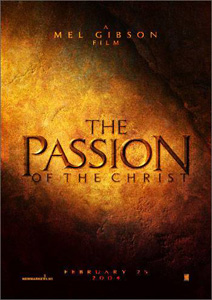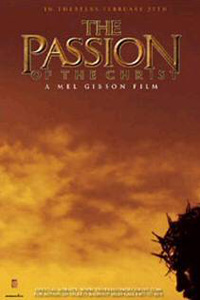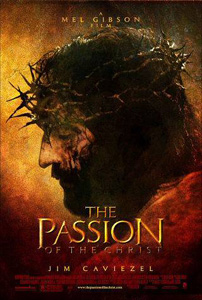![]()

![]()
directed
by Mel Gibson
USA 2004
In the last fifty years, films about the suffering of Jesus
has gone from being so broad, that they couldn’t offend any religion, to being
more and more theosophical with a personal twist. The two seminal works here
are Pasolini’s “The Gospel According to
St. Matthew” (marxist / political) and Scorsese’s “The
Last Temptation of Christ” (christology / theosophical). The latest
film to enter this line is Mel Gibson’s “The Passion of Christ” and where it
falls short of the intellect in the two just mentioned films, it belongs to
them, as, as them, it is the product of years of personal passion and
religious conflicts.
Gibson’s intentions is historical accuracy. Language is “authentic”, being
Aramaic, Hebrew and Latin, the costumes and set design is likewise. But here
the accuracy stops. Gibson is very liberal with his interpretation of the
Gospels and chooses only to tell the story of what happened in the hours
following the arrest of Jesus. Instead of approach this period theosophical,
he skips central passages – for instance he omits the line where Caiaphas
argues, that it is better for one man to die that the nation be saved – and is
far more occupied showing the physical torture and suffering of Jesus, that to
display the conflicts within the people involved in this (Caiaphas, Judas,
Peter, Pilates and Jesus himself). Hence, the film is an invasion on the
senses and not the intellect.
Some argue this is low and easy, but one can not argue against it being
effective. Its very painful to watch the physical torture. The message is
clear: Look at this, see what he suffered for you, see what he went thru,
before he died, for you and your sins. Personally I critic this approach, as
this emotional assault is forced upon us, as if Gibson blames us, and our
sins. This is underlined by the cinematography and Gibson’s mise-en-scene: As
Jesus dies, we see a drop of rain fall from the sky in perspective as a
teardrop from heaven, and that the very end, Gibson breaks the barriers of the
screen by having Mary look directly into the audience while kneeling at her
dead son. A most powerful image, as many others in the film, one can still
question the intention of such a frame composition in relation to the context
of the film.
But despite the critic, “The Passion of Christ” is far from a bad film, rather
the opposite, it’s a extremely powerful film and has a lot in common with the
political motifs of Pasolini, even though I wont compare the two films
directly. By a visual representation of the suffering of Jesus, it
contemporizes the passion to the imagery we see every day, when political
leaders or activists are killed for their beliefs. Love it or hate it, but it
remains an amazing film, full of passion.
Posters
 |
 |
 |
 |
Theatrical Release: February 25, 2004
Reviews More Reviews DVD Reviews
DVD Review: Scanbox - Region 2 - PAL
Big thanks to Henrik Sylow for the Review!
| DVD Box Cover |
|
CLICK to order from:
|
| Distribution |
Scanbox Region 2 - PAL |
|
| Runtime | 2:01:21 (4% PAL speedup) | |
| Video |
2.40:1 Original Aspect Ratio
16X9 enhanced |
|
|
NOTE: The Vertical axis represents the bits transferred per second. The Horizontal is the time in minutes. |
||
| Bitrate |
|
|
| Audio | 5.1 Dolby Digital Aramaic / Latin / Hebrew, DTS Aramaic / Latin / Hebrew | |
| Subtitles | Danish, Swedish, Norwegian, Finnish, Icelandic, None | |
| Features |
Release Information: Studio: Scanbox Aspect Ratio:
Edition Details: Chapters 15 |
|
| Comments |
As one of the most
controversial releases this year and as one of the most anticipated DVD
releases, the DVD is a huge disappointment. While it lacks the impact that only the big screen can give, the picture is stunning with its strong deep colours, so beautifully shot by Caleb Deschanel. Equally impressive is the sound, especially the DTS track. This is not a film where rears are challenged, but the sound is just “there”. The technical side is done with passion. The disappointment of the DVD is on the supporting side, which doesn’t exist. This is a personal project by Gibson, who even produced the film out of his own pocket and by his approach was challenged and attacked from various sides. An audio commentary where Gibson would discuss his approach, his sources, the structure, the production and so forth, would not only had been anticipated, but also welcomed. The production was the passion of Gibson, but his passion certainly is lacking on this DVD, both in form of an audio commentary, a documentary, TV clips and even simple press material. Perhaps this will come in a future 2-disc SE, perhaps never. |
|
DVD Menus
|
|
|
|
|
|
Screen Captures
|
|
|
|
|
|
|
|
|
|
|
|
|
|
![]()

![]()
DONATIONS Keep DVDBeaver alive and advertisement free:
Mail cheques, money orders, cash to: or CLICK PayPal logo to donate!
|
Gary Tooze
|
|
Many Thanks...
